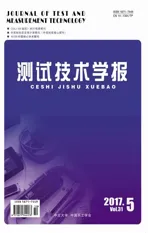基于十字线与双开口环结构的双频段左手材料
2017-10-18张效雄王佳云杨荣草
张效雄, 王佳云, 杨荣草
(山西大学 物理电子工程学院, 山西 太原 030006)
基于十字线与双开口环结构的双频段左手材料
张效雄, 王佳云, 杨荣草
(山西大学 物理电子工程学院, 山西 太原 030006)
本文提出一种将十字线与双开口环相结合的微波双频段左手材料, 在介质基板正反两面刻蚀相同的十字线与双开口环, 组成两个不同的谐振器. 通过高频电磁仿真软件HFSS对其电磁特性进行数值研究. 结果表明: 当电磁波垂直于入射时, 在两个磁谐振器上出现两个相应的电磁谐振而导致双频段的负折射率, 且具有负的介电常数和负的磁导率, 表现为左手特性. 同时, 通过对谐振点处电流分布图分析, 进一步验证了仿真结果的正确性. 最后讨论了该材料的主要结构参数对谐振特性的影响.
双频段左手材料; 负折射; 双开口环结构; 十字线
Abstract: In this paper, a dual-band left-handed metamaterial made of cross and double-split resonator rings (DSRR) structure is proposed in the microwave regime. The cross-DSRR structures etched on both sides of the substrate to constitute two different resonators. Numerical investigation is performed by high frequency electromagnetic simulation software HFSS. The results show that when the electromagnetic wave is normal incidence to the structure, there are two corresponding resonance frequencies appearing in two resonators, which result in negative refraction index at dual frequencies, where both the permittivity and the permeability are negative simultaneously. Meanwhile, the surface current distributions of the proposed structure at the resonance frequencies are analyzed to confirm the numerical results. Finally, the influence of major structural parameters on the resonance properties is discussed.
Keywords: dual-band left-handed metamaterial; negative refraction; double-split resonator ring structure; cross line
0 引 言
介电常数和磁导率是描述材料电磁特性的两个宏观物理量, 前苏联科学家Veselago在理论上提出: 当电磁波在介电常数和磁导率同时为负的材料中传输时, 电场、 磁场和波矢服从左手关系, 这种材料因此被称为左手材料[1]. 自然界本身不存在这种介电常数和磁导率同时为负的左手材料. 本世纪初, 在Pendry等人提出的开口谐振环与金属导线(SRRs-wire)构成谐振的理论基础上, Smith等人在实验上成功地研制了人工的左手材料[2,3], 这一开创性的成果开启了一扇新领域的大门, 激发了人们研究左手材料的兴趣[4-18]. 左手材料表现出诸如负折射效应、 逆多普勒效应、 逆契仑可夫辐射、 完美透镜效应等一系列新特性. 鉴于这些独特的特性, 使其在天线和隐身材料等领域具有潜在的应用价值[17-20]. 在左手材料不断发展的十几年当中, 基于经典SRRs-wire结构, 各种改进负折射材料不断被提出, 包括S型[4], H型[5], Ω型[6], 十字架型[7], 短金属线对型[8], 渔网型[9]结构等. 各种改进的左手材料主要在结构、 带宽、 损耗等方面有一定改善, 但其双负的左手频段还有很大的限制, 在实际的应用当中, 为了拓宽频带和增加频率的选择性, 设计多频段和宽频段的左手材料仍然是该领域的研究热点之一[12-18].
短金属线对结构为左手材料的构造提供了一种新思路[21], 当电磁波垂直入射时, 电场极化沿金属线方向, 在电场的作用下, 金属短线类似于细金属棒, 实现负介电常数; 磁场极化垂直于上下金属线构成的平面, 在磁场的作用下, 介质基板两侧的金属短线构成等效LC谐振电路, 在磁谐振频率附近实现负磁导率. 受其启发, 本文提出一种基于十字线与双开口环结构的双频段左手材料, 该结构结合了一对双开口环与一对十字线, 在介质基板的两侧刻蚀相同的双开口环与十字线, 在电磁波垂直入射的条件下, 介质基板两侧的双开口环对与十字线对分别构成两个不同的磁谐振器, 电磁波作用在两个谐振器上能够产生两个相应的电磁响应, 实现两个双负频段, 且表现为左手特性. 该结构对左手材料在双频以及更多频段的研究具有一定的参考价值.
1 基于十字线与双开口环结构的双频段左手材料
1.1 单元结构
本文提出的单元结构如图 1 和图 2 所示. 将方形双开口环与十字线刻蚀在介质基板的同侧, 介质基板为Rogers RT/duroid 6010材料, 相对介电常数为10.2, 介质基板的厚度d=1 mm, 方形开口环和十字线均为金属铜线, 铜线的电导率σm=5.88×107s/m, 铜线厚度dm=0.018 mm, 方形双开口环的边长l=3.8 mm, 开口间距g=0.94 mm, 十字线长度分别为l1=3.7 mm,l2=3 mm, 线宽w均为0.3 mm, 单元结构尺寸为4 mm×4 mm×1.036 mm. 在用高频电磁仿真软件HFSS对该结构进行仿真时, 平面电磁波电场、 磁场极化方向如图 1 中所示, 电磁波矢沿着Z方向垂直于单元结构模型射入.
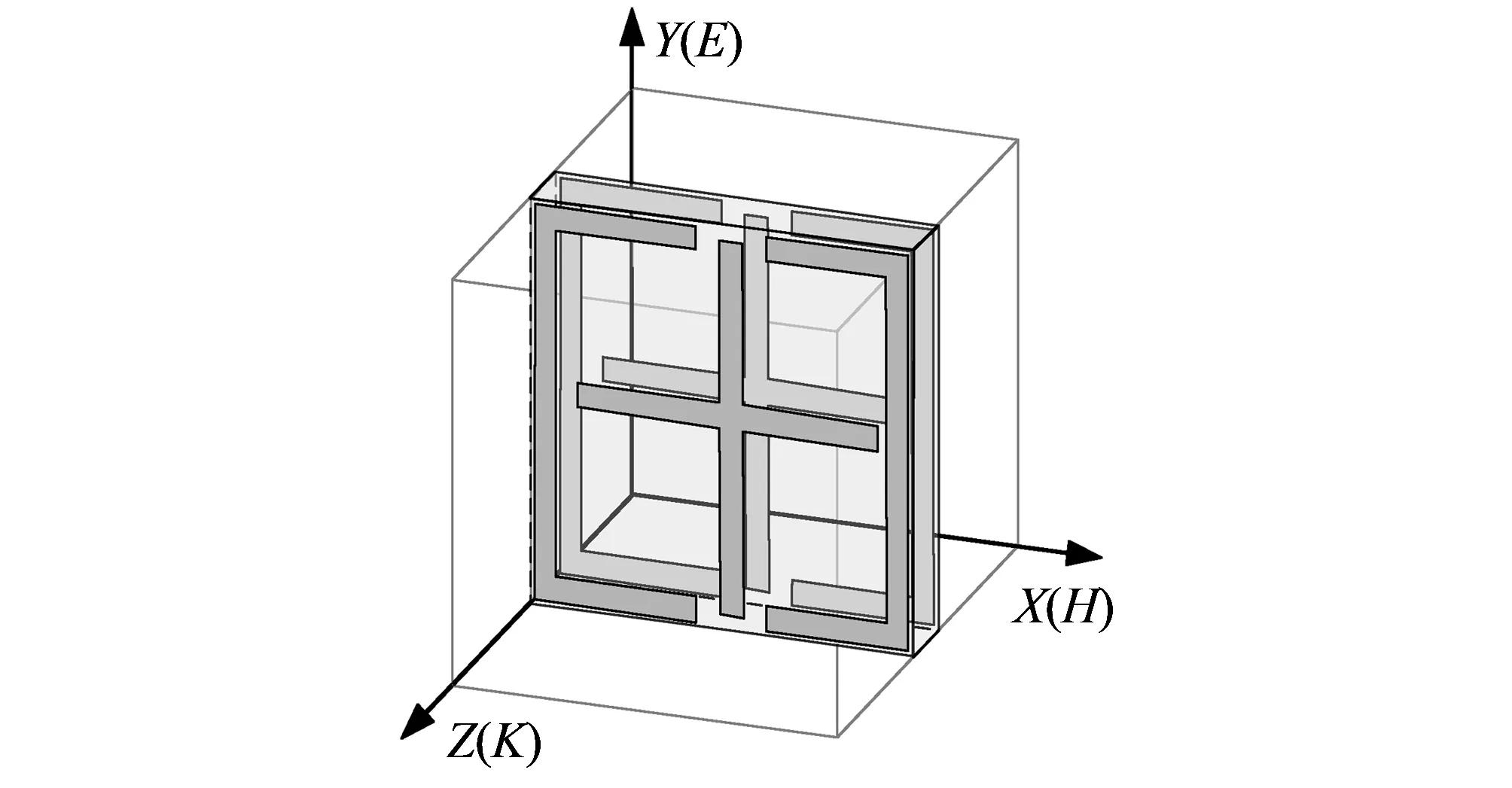
图 1 单元结构示意图Fig.1 Configuration of a unit cell
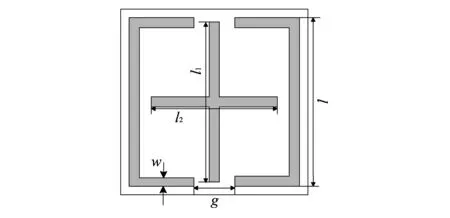
图 2 单面结构及参数标记示意图Fig.2 Single-side topology of the unit cell with parameter markers

1.2 S参数以及等效电磁参数的提取

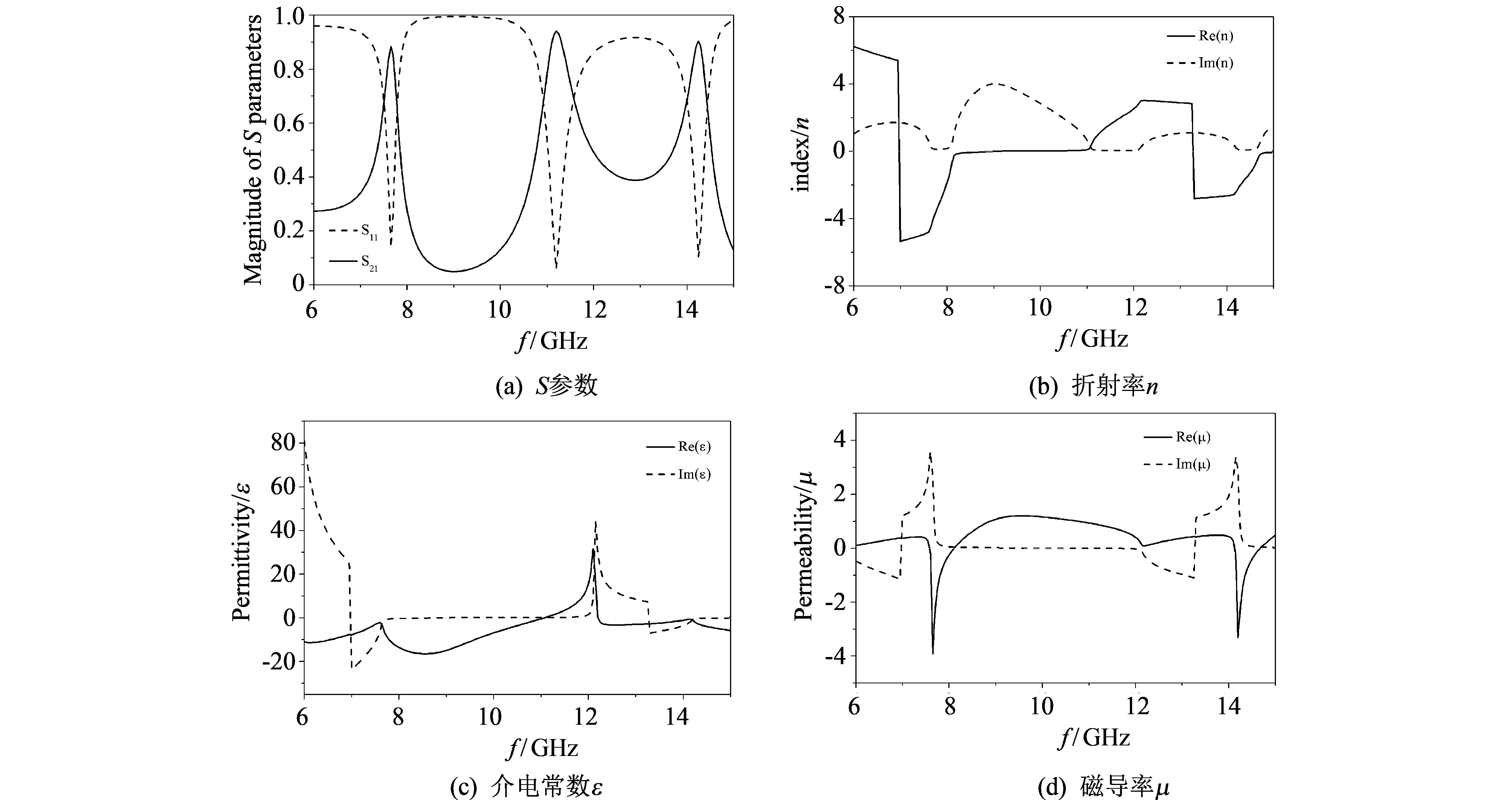
图 3 S参数及本构电磁参数随频率变化曲线Fig.3 S-parameters and retrieved constitutive EM parameters
从图 3(b)~图 3(d) 中可以看到该结构在7~8.2 GHz和13.2~14.7 GHz具有负的折射率, 在6~11 GHz 和12.2~15 GHz的两个频率范围内具有负的等效介电常数, 在7.6~8.1 GHz和14.1~14.7 GHz 的两个频率范围内具有负的等效磁导率, 因此该结构在7.6~8.1 GHz和14.1~14.7 GHz的两个频段内表现出左手特性.
1.3 电流分布分析
为了进一步分析所提出结构的谐振特性, 我们研究了该结构在3个谐振点处的电流分布. 图 4 给出了各谐振点7.62 GHz, 11.2 GHz和14.25 GHz处的电流分布图. 从图 4(a)和图 4(c)中可以看出, 在低频谐振点f1=7.62 GHz处, 前后双开口环产生一定强度的反平行感应电流, 与上下两端处的位移电流形成完整回路, 而前后十字线上的感应电流的强度很弱; 在高频谐振点f3=14.25 GHz处的前后反平行感应电流是在十字线上产生的, 双开口环对入射磁场响应非常弱, 形成的LC谐振电路在高频处实现负的磁导率, 对应于高频谐振; 另外, 从图4(a)和4(c)中还可以看到, 前面板的电流强度要略微强于后面板的电流强度, 这是由材料的损耗引起的. 而在谐振点f2=11.2 GHz处, 如图4(b)所示, 开口环对与十字线对结构上同时存在着同向平行的感应电流, 无法在结构的上下两端形成电容效应, 不能产生负的磁谐振. 以上电流分布结合图3所示的折射率分布表明: 低频(7.62 GHz)处的负折射率主要是双开口环对电磁波的响应形成的; 在高频(14.25 GHz)处, 十字线对结构对电磁波的响应产生负折射率; 而在11.2 GHz 频率附近, 电磁波在材料中传播时, 无法产生负的磁谐振而表现为正的折射率.
1.4 结构参数对谐振特性的影响

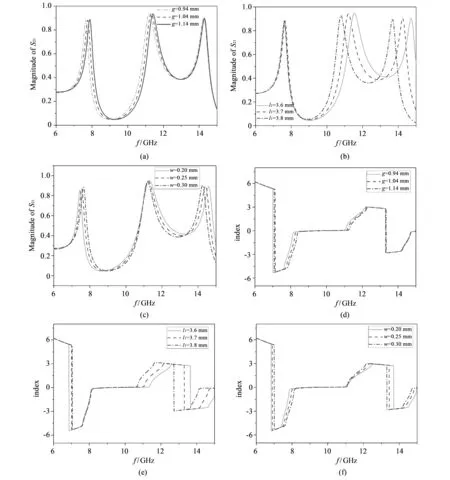
图 5 S21随(a)开口宽度g;(b)十字竖线长度l1 ; (c)线宽w的变化图; (d), (e)和(f)为对应的折射率变化图Fig.5 Magnitudes of S21 versus (a) the split width g; (b) the verticle length of the cross l1; (c) line width w; corresponding indexesindexes are shwon in (d) , (e) and (f)respectively
2 结 论
本文将一对双开口环与一对十字线将结合, 设计了一种基于十字线与双开口环结构的双频段左手材料. 利用HFSS电磁仿真软件数值研究了材料的电磁特性. 结果表明: 该结构在7.6~8.1 GHz和14.1~14.7 GHz 的两个频段内具有负的折射率, 且同时具有负介电常数和负磁导率的双负特性, 表现为左手行为. 同时对低频和高频谐振频率处的电流分布图进行了理论分析, 进一步验证了上面数值结果的正确性. 最后, 讨论了材料结构参数的变化对谐振特性的影响. 本文所提出的左手材料结构简单, 易于制造, 对于设计双频段以及多频段的左手材料具有一定的参考价值.
[1] Veselago V G. The electrodynamics of substances with simultaneously negative values ofεandμ[J]. Sov. Phys.Usp, 1968, 10(4): 509-514.
[2] Smith D R, Padilla W J, Vier D C, et al. Composite medium with simultaneously negative permeability and permittivity[J]. Phys. Rev. Lett, 2000, 84(18): 4184-4187.
[3] Shelby R A, Smith D R, Schultz S. Experimental verification of a negative index of refraction[J]. Science, 2001, 292(5514): 77-79.
[4] Chen Hongsheng, Ran Lixin, Huangfu, et al. Left-hand material only composed of S-shaped resonator[J].Phys. Rev. E, 2004, 70(5): 057605.
[5] Liu Yahong, Luo chunrong, Zhao Xiaopeng. H-shaped structure of left-handed metamaterials with simultaneous negative permittivity and permeability[J]. Acta. Phys. Sin, 2007, 56(10): 5883-5889.
[6] Huangfu Jiangtao, Ran Lixin, Chen Hongsheng, et al. Experimental confirmation of negative refractive index of a metamaterial composed of Ω-like metallic patterns[J].Appl. Phys. Lett, 2004, 84(9): 1537-1539.
[7] Wang Jiafu, Qu Shaobo, Xu Z, et al. A broad-band three-dimensional isotropic left-handed metamaterial[J]. J. Phys. D: Appl. Phys, 2009, 42(15): 155413.
[8] Zhou Jiangfeng, Zhang Lei, Tuttle G, et al. Negative index materials using simple short wire pairs[J]. Phys. Rev. B, 2006, 73(4): 041101.
[9] Dolling G, Enkrich C, Wegener M, et al. Simultaneous negative phase and group velocity of light in a metamaterial[J]. Science, 2006, 312(5775): 892-894.
[10] Dolling G, Enkrich C , Wegener M, et al. Low-loss negative-index metamaterial at telecommunication wavelengths[J]. Opt. Lett, 2006, 31: 1800-1802.
[11] García-Meca C, Ortuo R, Salvador R, et al. Low-loss single-layer metamaterial with negative index of refraction at visible wavelengths[J]. Opt. Express, 2007, 15(15): 9320-9325.
[12] Sabah C. Multiband planar metamaterials[J]. Microwave. Opt.Technol. Lett, 2011, 53: 2255-2258.
[13] Chen Zhi, Zhang Yaxin. Planar terahertz metamaterial with three-resonant frequencies[J]. Chin. Phys. B, 2013, 22(6): 067802.
[14] Sabah C, Member. Multiband metamaterials based on multiple concentric open-ring resonators topology[J]. IEEE. J. Sel. Top. Quant, 2013, 19(1): 8500808.
[15] Liu Yahong, Zhou Xin, Song Kun. Quasi-phase-matching of the dual-band nonlinear left-handed metamaterial[J]. Appl. Phys. Lett, 2014, 105(20): 201911.
[16] Gui Yan, Yang Bin , Zhao Xiaoqing. Angular and polarization study of flexible metamaterials with double split-ringresonators on parylene-C substrates[J]. Appl. Phys. Lett, 2016, 109(16): 161905.
[17] Zhang Linbo, ZhouPeiheng, Chen Haiyan, et al. Ultra-thin wideband magnetic-type metamaterial absorber basedon LC resonator at low frequencies[J]. Appl. Phys. Lett, 2015, 121(1): 233-238.
[18] Iman Ben Issa, Mohamed Essaaidi. A novel compact multibandbroadside-coupled split-ring resonatormetamaterialstructure loaded fractal slotAntenna for 4G communicationsand wireless systems[J].Microw. Opt. Techn.Let, 2016, 58(12): 2823-2828.
[19] Wang Junqiao, Zhang Jia, FanChunzhen, et al. Electromagnetic manipulation in planar nanorod antennas for metamaterial slow light application[J]. Opt. Com, 2017, 383: 36-41.
[20] Wang Ben-Xin. Single-patterned metamaterial structure enabling multi-band perfect absorption[J]. Plasmonics, 2017, 12(1): 95-102.
[21] Zhou Jiangfeng, Economon E N, Koschny T, et al. Unifying approach to left-handed material design[J]. Opt. Lett, 2006, 31(24): 3620-3622.
[22] Smith D R, Vier D C, Koschny Th, et al. Electromagnetic parameter retrieval from inhomogeneous metamaterials[J]. Phys. Rev. E, 2005, 71: 036617.
ADual-BandLeft-HandedMetamaterialComposedofcrossandDouble-SplitResonatorRingStructure
ZHANG Xiaoxiong, WANG Jiayun, YANG Rongcao
(College of Physics and Electronic Engineering, Shanxi University, Taiyuan 030006, China)
1671-7449(2017)05-0455-06
TN015
A
10.3969/j.issn.1671-7449.2017.05.015
2017-03-22
国家自然科学基金资助项目(61178013); 山西省自然科学基金资助项目(2016011038)
张效雄(1992-), 男, 硕士生, 主要从事电磁超材料方面的研究.
杨荣草(1970-), 女, 教授, 博士, 主要从事光信息传输与电磁超材料方面的研究.
